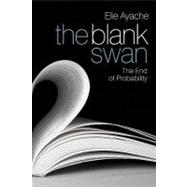
Note: Supplemental materials are not guaranteed with Rental or Used book purchases.
Purchase Benefits
What is included with this book?
PART I WRITING AND EVENT.
1 Writer of The BLANK Swan.
1.1 Prediction versus Prescription.
1.2 Generalizing Prediction.
1.3 The Derivatives Market.
2 The Writing of Derivatives.
2.1 First Steps on the Surface.
2.2 Introducing Contingency.
2.3 The Pricing Surface.
3 The Event of the Market.
3.1 From States of the World to Market Prices.
3.2 The Black–Scholes–Merton Paradigm.
3.3 The Critique of Derivative Pricing Theory.
3.4 The Necessity of Meta-Contextual Ascent.
4 Writing and the Market.
4.1 Pierre Menard.
4.2 Reading and Writing.
4.3 Approaching the Market.
PART II ABSOLUTE CONTINGENCY AND THE RETURN OF SPECULATION.
5 The Necessity of Contingency.
5.1 Against Speculation.
5.2 Speculative Materialism.
6 Passage to the Future.
6.1 From Possibility to Inexistence.
6.2 The Passage.
6.3 The Future 156
7 Necessity of the Future.
7.1 A Model World.
7.2 The Implied Absolute.
8 Necessity of Writing.
8.1 Radical Speculation.
8.2 The Pricing Alternative.
8.3 From the Market to Work.
PART III FLIGHT TO SYDNEY, OR THE GENESIS OF THE BOOK.
9 The Mathematics of Price.
9.1 The Absolute without Thought.
9.2 The Absolute within Thought.
10 Barton Fink.
10.1 The Pledge.
10.2 The Turn.
11 The Narrative Adventure.
11.1 The Line of Flight.
11.2 The POINT of the World.
12 Out of the Box.
12.1 The Purple Gastropod.
12.2 The Point of Return, the Point of Inversion.
2.3 How to be a Writer.
13 The Prestige.
13.1 Finding the Market, Binding the Book.
13.2 Absolute Deterritorialization.
14 The Geographical Process.
14.1 The Field of Ruins.
14.2 Landing on the Market.
PART IV CONVERSION OF CREDIT INTO EQUITY, OR THE GENESIS OF THE MARKET.
15 History of the Market.
15.1 The Conversion.
15.2 Possibility versus Contingency.
15.3 The Market.
16 From Debt to Equity.
16.1 Deduction of the Contingent Claim.
16.2 Deduction of the Exchange.
16.3 Deduction of Price.
17 The Market and the Philosophy of Difference.
17.1 The Pit of Price.
17.2 The Market and Time.
17.3 The Market and Difference.
18 Future of the Market.
18.1 The Category of Price.
18.2 The Step Beyond.
18.3 Place and Contingency.
18.4 Conclusion.
19 Appendix 1 The Logic and Mathematics of Regime Switching.
A1.1 Description of the Regime-Switching Model.
A1.2 General Backward Equations.
A1.3 Credit Default Swaps.
A1.4 Calibration.
A1.5 Recalibration.
20 Appendix 2 From 'Being and Time' to 'Being and Place' with Jeff Malpas.
Bibliography.
Index.
The New copy of this book will include any supplemental materials advertised. Please check the title of the book to determine if it should include any access cards, study guides, lab manuals, CDs, etc.
The Used, Rental and eBook copies of this book are not guaranteed to include any supplemental materials. Typically, only the book itself is included. This is true even if the title states it includes any access cards, study guides, lab manuals, CDs, etc.